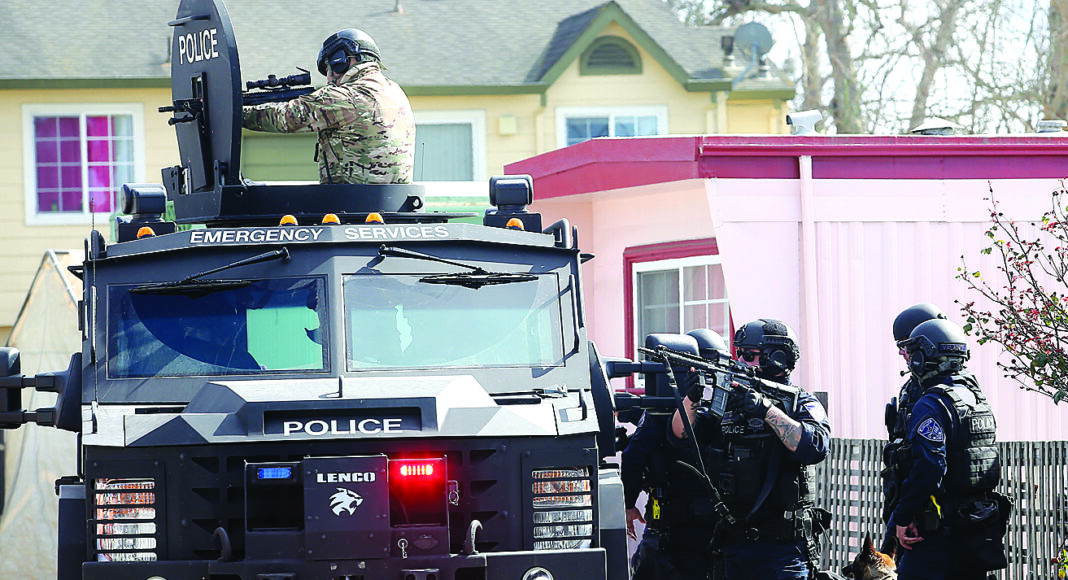Santa Cruz Police Chief Bernie Escalante says there wasn’t a particular “rhyme or reason” that prompted him to apply for the BearCat, the police department’s SWAT armored combat vehicle, in 2015. Escalante, who was announced as Santa Cruz’s next Police Chief on April 26, says that he simply saw the vehicle as a practical investment, one that would save lives.
The BearCat, a hulking 17,550-pound tank on four wheels that the department calls an “Armored Personnel Carrier vehicle with entry apparatus attached,” was a controversial acquisition at the time. Protesters filled the Santa Cruz City Council chambers in response to the council’s decision to accept a grant for the armored vehicle. At the same time, protests were still erupting across the nation in response to the 2014 killing of Michael Brown, an unarmed Black teenager, by a police officer.
Seven years later, the BearCat is still a source of contention.
The vehicle was brought up again during the most recent city council meeting, as they discussed the implementation of Assembly Bill 481, a new state law that went into effect at the beginning of the year. The law, which requires police departments to publicly disclose all of their military-grade weapons, is part of a broader effort to increase transparency and accountability within police departments. It also requires departments to draft a publicly available military-weapons-use policy, to give an annual report on all costs related to the military weapons and to get a sign-off from councilmembers before purchasing new military weapons, among a few other requirements. SCPD’s policy was unanimously approved by the council.
During the council meeting, the police department listed the BearCat, chemical agents like tear gas and four high-caliber guns during its presentation, among other items. It didn’t list its inventory of AR-15s, because those semi-automatic rifles—a weapon known as an “ArmaLite” rifle that has been used in some of the nation’s deadliest mass shootings—do not fall under the state’s military-grade classification. The council moved to classify AR-15s as military weapons moving forward.
Many people showed up to decry the use of the armored vehicle and AR-15s, and urged the city council to dispose of them.
“This is not 2015, when maybe there was something in someone’s mind that said the militarization of the police was not a bad idea,” Tim Fitzmaurice said.
Across the county, police departments have been coming into compliance with AB 481, prompting some citizens and council members to renew calls for demilitarization of police departments. Members of the public across the county say that at the heart of this law is an effort to demilitarize police, and city leaders should act with that intention.
Escalante says that these weapons are critical for officers to safely do their jobs, and that there really aren’t reasonable alternatives.
“I’ve been here for 25 years. We’ve had all of this equipment for the last 25 years,” Escalante says. “I feel confident and proud to say that because of the layers of policy that already exist, we’ve been able to resolve complicated situations without the use of lethal force because of these tools.”
Policy is King
Dr. Ginger Charles, a retired police sergeant and chair of the Criminal Justice program at Cabrillo College, says that having military weapons isn’t as much of a concern as the policies in place that guide their training protocol and use.
“Having a BearCat, for instance, isn’t necessarily a bad thing,” says Charles. “But there should be such a narrow, narrow margin as far as when it’s deployed. There should be really strict guidelines about that, and there should be extreme training in regards to using that, too.”
Escalante says that the police department must issue a report every time the BearCat leaves its facility, even just to get gas. Its deployment must be based on the specific circumstances of a critical incident, and will only be driven by a trained officer.
While officers don’t have to complete a certain number of hours of training, they do need to be versed in standard safety protocols. And there are exceptions: if there was an emergency where the BearCat was critically needed, any officer could drive it, Escalante says. In 2021, the BearCat was deployed 19 times: 11 of those times were for maintenance and training reasons.
Charles says that, importantly, an agency must be very transparent about why they have the weapons they do, and why they think they’re needed. According to Charles and Escalante, crime is on the rise, and officers are leaving departments because of it. They say these weapons help keep officers and the public safe, and that limiting access to them would make it harder to retain officers.
“I would say that officers would feel less safe if they don’t have access to these tools,” Escalante says. “They are already not being provided with the proper tools and equipment and technology that’s available to the industry.”
Still, for some, that reasoning isn’t sufficient.
When it comes to transparency within the police department, Executive Director for the Center for Nonviolence Silvia Morales is all for it. Yes, she supports the police department disclosing military weapons, but she also wants something that is perhaps just as important: to understand how police departments arrive at the decision that such weapons are needed.
“The process used to determine what equipment gets acquired needs to be clearly presented to the public, and is essential moving forward,” says Morales. “The police department needs to spend more time and resources looking for nonviolent ways of policing, rather than purchasing high-powered weaponry.”















It was useless during the hunt for murderer C arillo 2 yrs ago when it comically scooted down the street to where a lone private citizen marital artist has already deftly (& barehanded) disarmed the shooter.
Policing by Consent…. All this militarization overwhelms any concept of consent. It polarizes and divides, fearful and feared. And, it really hasn’t justified its gas bill. Look at that gun turret. It’s disgusting.